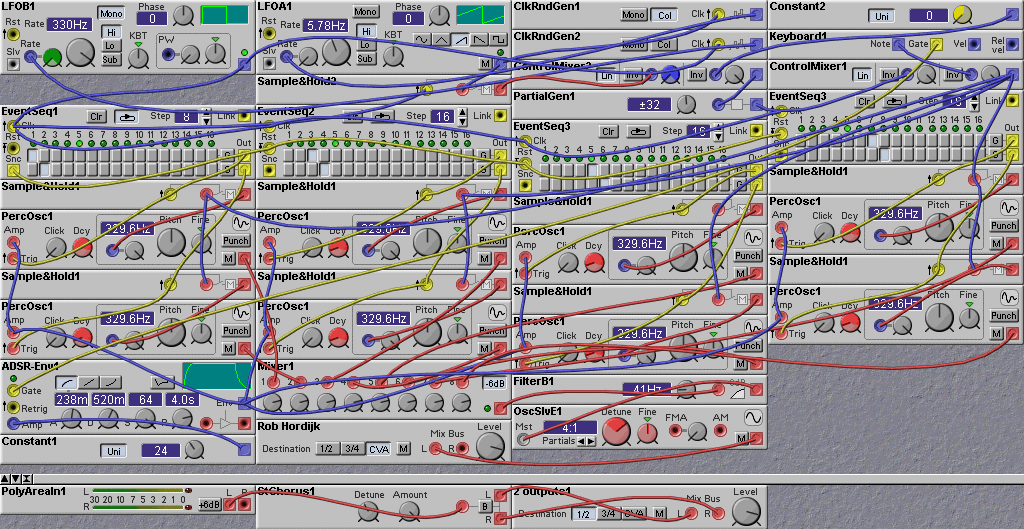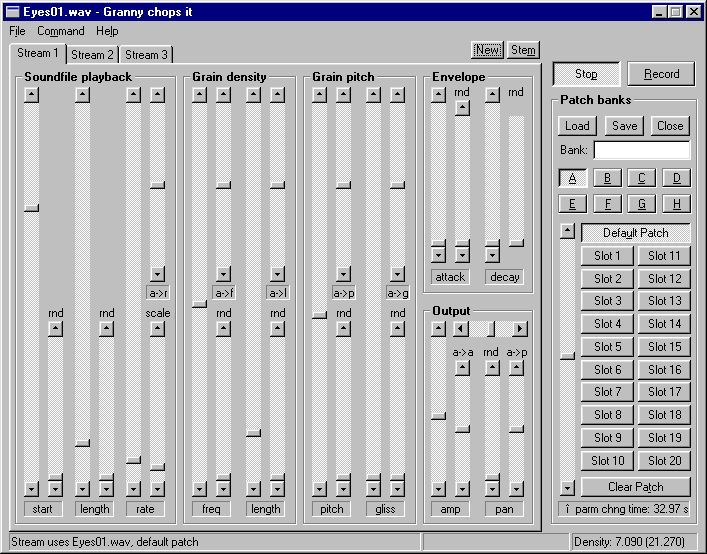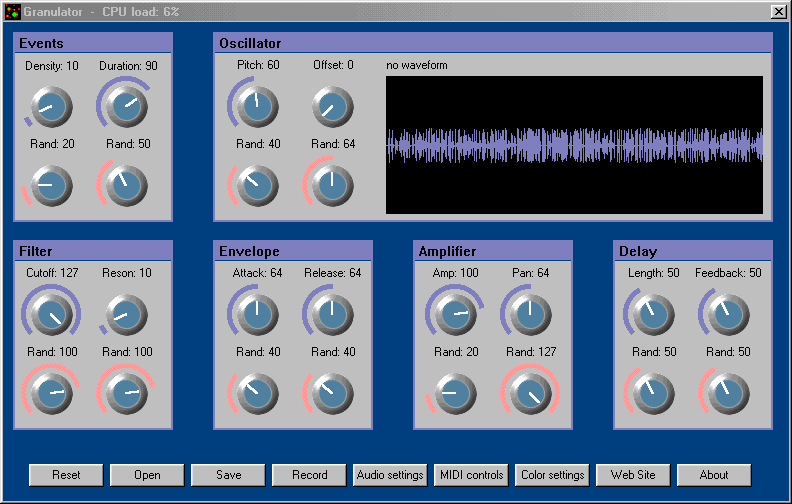 Granular Synthesis
Granular Synthesis Granular Synthesis
Granular Synthesis
1LStilwell wrote:
I'm just curious. What is granular synthesis? What kind of sounds can you produce with it? I've been seeing a lot of talk about it on the list in the past few days and it's a new term to me. I also heard that the modular is not capable of this type of synthesis because it requires RAM or something like that. Not that it matters, but will the modular ever have the capacity to use granular synthesis?
Noisplong wrote:
I do use reaktor, more and more, and I love it! To all those who think it is too simple or not powerful enough compared to kyma... Guess you must be gearaholic snops ... Its incredible powerful, specially for the fact that it runs on win or mac machines, and is completely modular...
David McClain wrote:
While the Nord is not capable of directly synthesizing granular sounds, it can certainly be used to process them as audio. You can do just about anything you want to those sounds with the Nord! (except long delay line effects)
Granular sounds (jump in here anybody!) produce any number of "Sounds". They are based on the concept of grains of sound, or sound quanta - named by Gabor(?) in the 1930's. He was a physicist that postulated that sound could be composed of individual quanta. Each one is a short segment of sound, typically 20 ms or so, shaped by an envelope, e.g., Gaussian. By themselves they sound like clicks. They have no definite pitch. (There are many variants to Granular though, and you should find some answers on this list that disagree with this one!).
By stringing together many individual sound quanta, you can synthesize pitched sounds. The character of those sounds depends very strongly on the density and spacing of the quanta, the shape of their grain envelopes, and the underlying carrier frequency. You could think of the quanta as the impulse response of an instrument. Hence, varying the envelopes and the carrier frequency allows the synthesis of a huge variety of sounds. With this impulse response, you might consider that the filtering has already been done. The impulse response carries the information about the "formants" of the instrument. The repitition rate of the quanta give rise to pitched sound through these formants.
Of course, being music, everything is subject to reinterpretation and "rule breaking". The sky is the limit here! One frequently hears granular synthesis acting like drops of sound, or a "solid" sound evaporating into droplets and scattering. The Kyma system even allows the grains to follow in loose clusters much like a flock of birds. As the "lead" grains change pitch, so too do all the following grains, but with delay and overshoot.
Well, I am hardly the "expert" in Granular to answer this question. But from what little I have done on Kyma with regard to granular synthesis, and with my experience in other kinds of sound-crafting, I would do the following:
Choose a modulation rate, or envelope duration, commensurate with one or more grain durations. By commensurate, I mean use a modulation rate that is some integer submultiple of the grain repetition rate, or an integer multiple of the grain envelope duration.
You aren't controlling all grains simultaneously, just the few that fall within the window of modulation. And you aren't exactly naming the particular grain(s) being affected, but it is predictable, even if the effect is periodic. But, as you know, Kyma allows gradual evolution of things like wavetables and modulation envelopes. So even though you could identify the grains being affected, the variation does not have to repeat itself.
Like I said previously, altering a single grain would be almost useless. You have to affect some number of them in order to have a noticeable effect. Now, on the other hand if you choose a large enough ratio, though still commensurate, it would affect many more grains and have a longer lasting effect. At the same time it would be harder to identify any particular grain as having been affected. Also, by choosing an irrational ratio, or a ratio of two large, relatively prime, values then, of course, after a cycle or two you would be unable to track which grains were affected.
There are a vast number of possibilities -- not quite infinite, but in human terms it may as well be considered so. I'd like to hear some other responses to this same question, because I'm certainly no expert here!
Rob Hordijk wrote:
Once send the patch
GrannyFMB.pch to this list that is a bit granular synthesis like. It uses four event sequencers to generate 8 separate pulses to trigger 8 AD env's. As the triggers are one after another its like 8 grains or quanta.You can play around with the material you feed the AD's to get all sorts of sounds that sometimes can sound like sounds normally associated with granular synthesis. But as the NM has no long echo/delayline or samples from where you could get the input, you're bound to use oscillators as input.
Here is a patch that uses PercOsc modules. Red morph -> grain decay, green morph -> fundamental random jitter, blue morph -> grain freq random jitter, yellow morph -> grain basic freq. You can increase the effect by e.g. adding pitchshifters with delayed feedback and/or some long grotto reverb.
 A little tuneup of the granular one with the PercOsc modules so its nicely playable on a keyboard.
A little tuneup of the granular one with the PercOsc modules so its nicely playable on a keyboard.
Added is a waveshaper made from a simple "zero fm oscillator". The grains are tuned on a harmonic scale thankx to the partial generator (which should be used before a Pitch input of an oscillator to generate the harmonic series and not on the audio, well that does something very nice as well but that's a different story). Default it sounds like an FM pad patch, but tweak the knobs...
 And using Sample and Hold Modules
And using Sample and Hold Modules
Perdro Monkeyfinger wrote:
Palle Dahlstedt wrote:
Other application for granular synthesis:
At
http://hem.passagen.se/rasmuse/Granny.htm is a freeware application for creating granular synthesis using *.wav files.
It is mentioned here because the Nord Modular's Knobs are able to control the settings by using the following Patch:
For more information, see the Site and the Manual of GranuLab. BTW also availlable is a wonderfull PixelToSound synthesizer, Guagula.
Another nice granular synthesis Tool is Granulator, designed by ListMember Nicolas Fournel, which is free downloadable at
http://www.nicolasfournel.com/downloads/granulator.zip